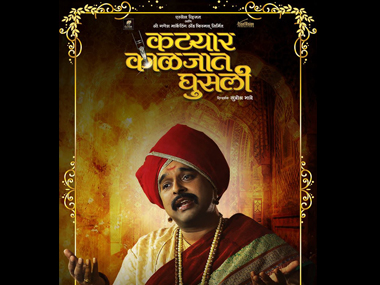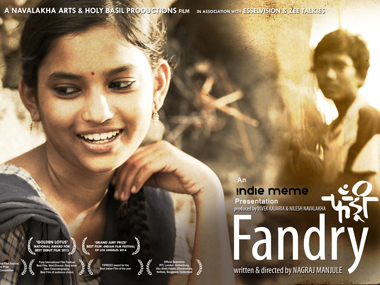Let us crunch a few numbers to begin with. Bengali films have won 22 SwarnaKamals (National Film Award for Best Feature Film) since the inception of the award compared to 13 Hindi, 11 Malayalam,6 in Kannada and 4 Marathi among others. But since 2000, there have been 3 each from Marathi, Malayalam and Hindi, easily overshadowing all other languages.
Similarly, big budget Bollywood films have been regularly considered as official entries to Oscar from India followed by some big budget Tamil films. Apart from them there have been a couple of Bengali films by Ray and some Malayalam arthouse films in the earlier decades. However, since 2001, we have had three Marathi films considered for this purpose, more than any other language apart from Hindi.
Apart from them, Marathi films have won many other national and international awards in the last decade or so, finally reaching pinnacle this year with Killa, which shone at Berlinale and Court, which won not one but two awards at the prestigious Venice International Film festival along with a host of other awards worldwide. Yes, the Marathi films have been going through a revival and if you are a film lover but have not noticed this trend, then you are surely missing out on some really great films of late.
The Land of Stalwarts:
Indian cinema was originally spearheaded by Marathi stalwarts like Dadasaheb Phalke, who is still considered the father of Indian cinema and Dadasaheb Torne, who lost out on the same honour due to technical reasons (His first film preceded that of Phalke?s but was processed overseas). In the silent era the language probably was not much of an issue but even after the talkies arrived, Marathi cinema held on its own and legends such as V Shantaram achieved equal success in Hindi and Marathi cinema. However, due to the fact that entire Bollywood also was located within Maharashtra, it slowly overshadowed the Marathi cinema with its glamour and financial muscle, thus leading to its decline. So, by 90s, we were left with nothing but a few generic comedies desperately trying to retain the market share against the onslaught of Bollywood.
However, in the 21st century, a new generation of Marathi filmmakers have taken it upon themselves to make up for the same and they have been spectacularly successful to say the least. From Fandry to Harishchandrachi Factory and from Deool to Court, they have achieved both critical acclaim and commercial viability without ever diluting creative ambitions for populism. It is a story of resurgence worth telling. Even now the critics are going gaga over Katyar Kalijat Ghusli, a complex character study with the backdrop of classical music.
The story of resurgence probably started with Sandeep Sawant?s Shwas, story of a child suffering from a terminal illness which became India’s official entry to Oscars. It rekindled the collective desire in an entire generation of artists to reclaim the past glory. The new breed of filmmakers are better exposed to various types of cinema from all over the world and not intimidated by the clout and popularity of Bollywood. In fact, many of these filmmakers, technicians and actors have done well to maintain a parallel working relationship with Bollywood, thus giving them access to better facilities and ensuring financial stability.
Fresh Blood:
The primary reason for this optimism around Marathi ?New Wave? is the fact that they are being brought about by genuinely new talents. Most of the highly acclaimed films have been made by first or second time directors in their 20s and 30s. Chaitanya Tamhane was barely 26 years old when he finished making Court. So, in a way, it is just the beginning and all these auteurs seem to have long and bright careers ahead. Apart from him we have the likes of are gradually pushing the boundaries of ambition both in terms of creativity and content.
Brave Experiments:
The most noticeable aspect in this regard has been the range of issues and genres touched upon by these new films. Several films like Shwas, Killa, Vihir, and Fandry have very young or adolescent protagonists with strong social or political backdrops. Mahesh Limaye?s Yellow on the other hand deals in a redeeming, real life story of a special needs child who becomes and award winning swimmer, that too with the person playing herself. On the other hand Paresh Mokashi?s Harish chandrachi Factory is the kind of endearing and passionate tribute to older stalwarts that Bollywood has spectacularly failed at in making. Satish Manwar?s Gabhricha Paus on the other hand takes up the issue of farmers? plight in the drought stricken Vidrabha region while Nikhil Mahajan?s Pune 52 delivers a stylish neo-noir thriller set amidst the middle class society of Pune.
Commercial Success:
What differs these films from older generation idealistic parallel cinema is their ability to engage and entertain effortlessly, without selling their soul for cheap gimmickry. These filmmakers have also been smart with their collaborations and marketing efforts and so a whole new generation of Marathi filmgoers flocking the theatres to watch these films. For example, the highest grossing Marathi film from 2010 was Ravi Jadhav?s Natarang, the story of a man who chooses to play an effeminate character in the local folk theatre. On paper it hardly looks like blockbuster material, especially if one is used to what Bollywood considers as ?saleable?.
Emergence of a Supportive Ecosystem:
One important requirement for an industry to grow and sustain is to have a functioning and supportive ecosystem. The good news for Marathi cinema is that it has managed to build this ecosystem, partly through its own effort and partly through government support. After it showed signs of recovery, the Maharashtra the government also decided to pitch in by announcing a grant for Marathi films. These grants help chosen projects by new filmmakers to start off easily, who would otherwise have had to waste years waiting for a producer to fund the same. In fact it would not have been very likely considering the bold themes they are handling nowadays.
Similarly, consistent success and publicity of these films have made bigger production houses as well as celebrities of Bollywood take note and throw their weight behind these films. For instance Vihir was produced by Corporation while Riteish Deshmukh pitched in to produce Balak Palak and Yellow. These developments have also ensured that the industry is financially secure and the talents are not being wasted or made to wait due to dearth of resources.
The industry has also benefitted from already existing talent pool. Marathi theatre scene has always been vibrant and these actors used to regularly find their way to Bollywood. But now actors like Atul Kulkarni and Sonali Kulkarni have a good deal of opportunities to exploit in their home turf. Even bona fide Bollywood stars like ShreyasTalpade and Riteish Deshmukh are realizing the shift and trying their luck in Marathi cinemas. Deshmuk this year starred in Nishikant Kamath?s Lai Bhaari, an action drama which became the highest grossing Marathi film ever by raking in around 40 crores, no mean feat considering the market that is restricted to only one state.Talpade?s attempt called Baji was not as successful but this vigilante/superhero film by Nikhil Mahajan turned out to be another experiment in an untouched genre.
So, overall, it can be said that the Marathi Film Industry has managed to claw back after a period of lull in the first decade and a half of the 21st century and we are surely looking at a purple patch for the next decade too. How exactly it evolves and where it goes from here has to be seen but for a genuine film lover, they are surely offering a lot to explore.




These days filmmakers in India are able to express themselves in almost any language.These type of freedom was much awaited.
Marathi Film industry has talent and potential maybe more than Bollywood but still it lacks because of promotional activities and exact target audience. So inorder to understand the target class and how other marathi films can get exposure a survey is done.
Please fill this : https://docs.google.com/…/1eX13NOluesxp42O9…/viewform…
Also there is an upcoming romantic comedy movie called “Photocopy”, the survey intends to find out apt promotional tools for it too. THANKYOU.
https://docs.google.com/forms/d/1eX13NOluesxp42O9YiGs20yO4j1eGPXNKKkOpOiq_WM/viewform?c=0&w=1
Link mentioned was broken.. sorry but the full one is here 😀
Good movies are always appreciated….
I am looking forward for this one
https://www.facebook.com/theMovieBhoBho/?fref=ts